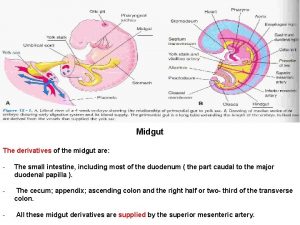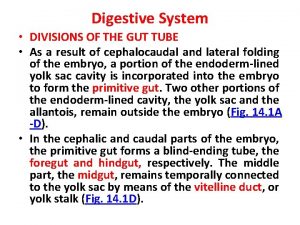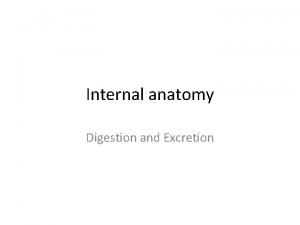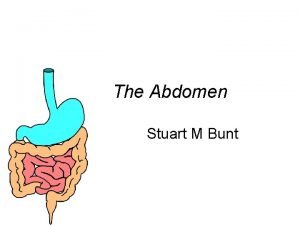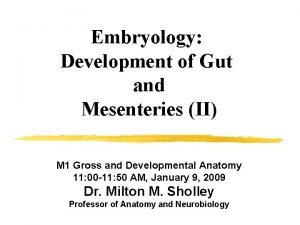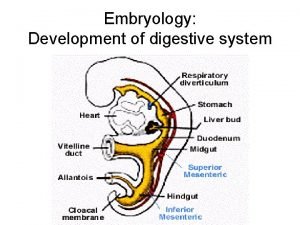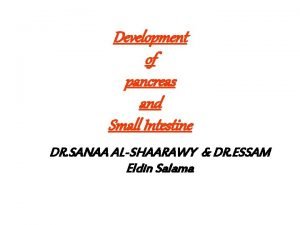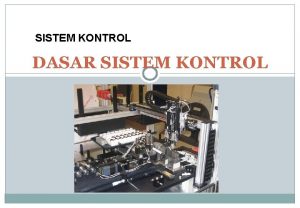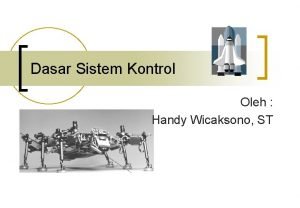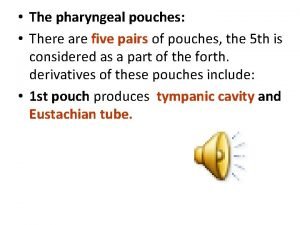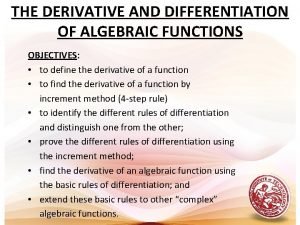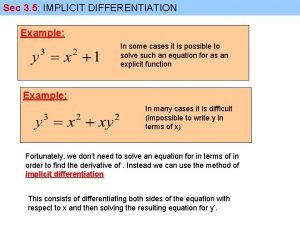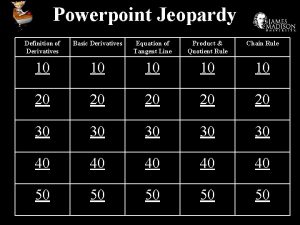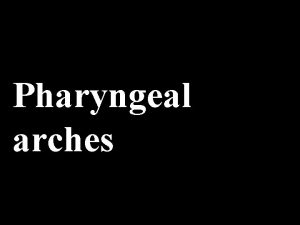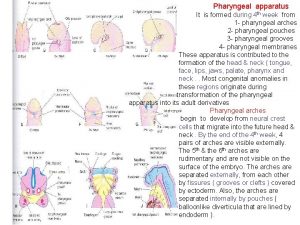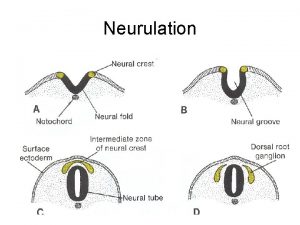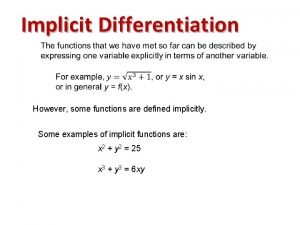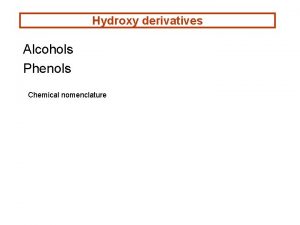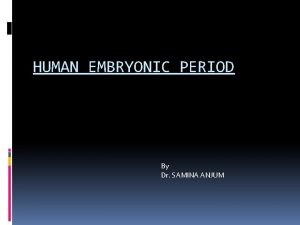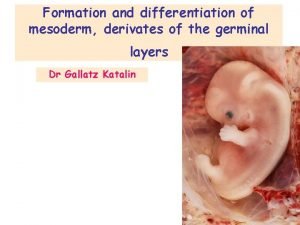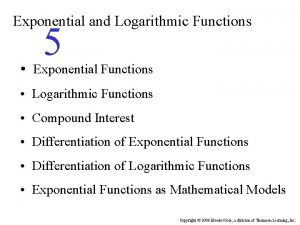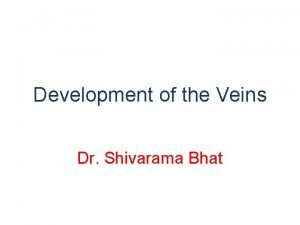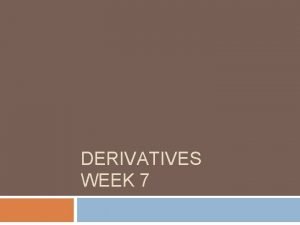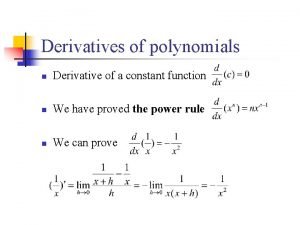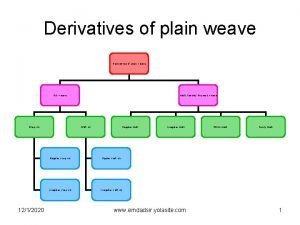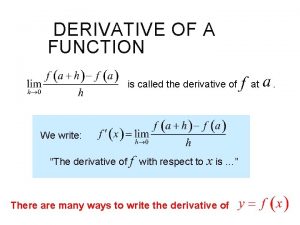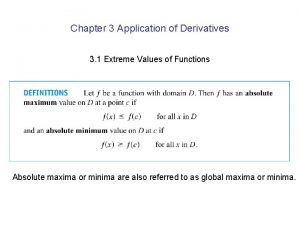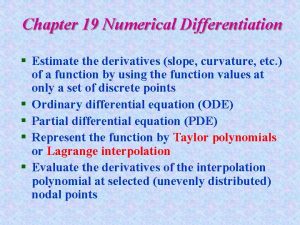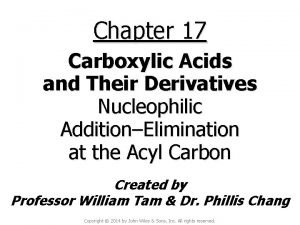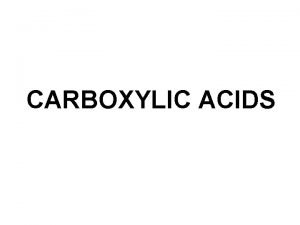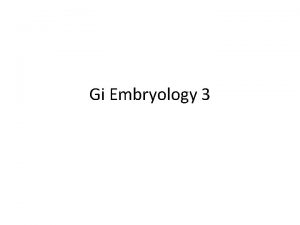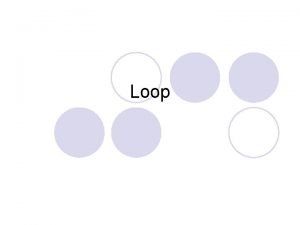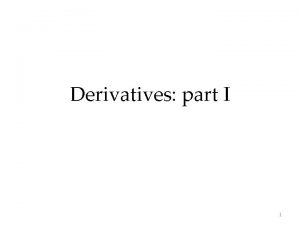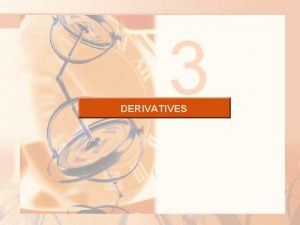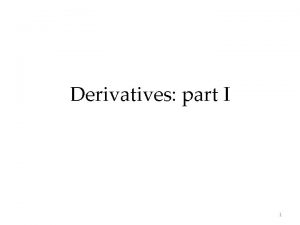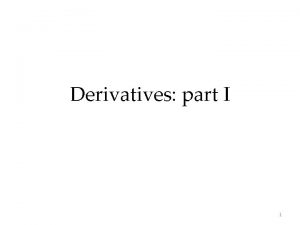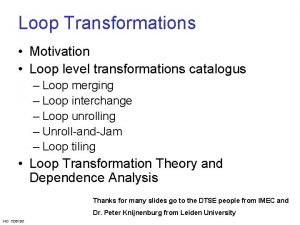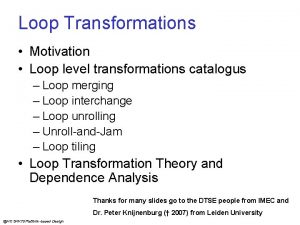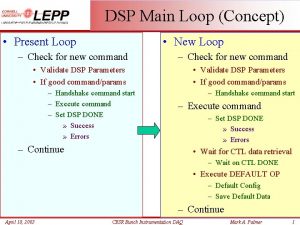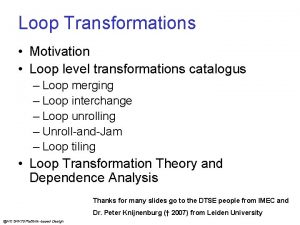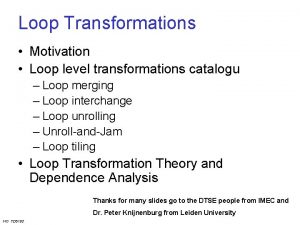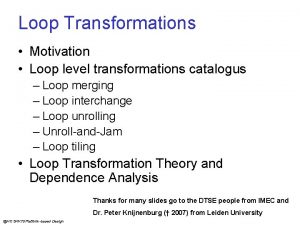Development of Midgut loop Derivatives of midgut loop














































- Slides: 46

Development of Midgut loop: § Derivatives of midgut loop are: 1 -Small intestine, including most of duodenum. 2 -Cecum & appendix. 3 -Ascending colon. 4 -Right 2/3 of transverse colon. § All these derivatives are supplied by superior mesenteric artey (artery of midgut)

Development of midgut loop ØAt the biginning of 6 th week, the midgut elongates to form a venteral U-shaped midgut loop projecting into extra-embryonic coelom of proximal part of umbilical cord …this called physiological umbilical herniation. ØAt this stage the arrow indicates communication of intraembryonic coelom (peritoneal cavity) with extraembryonic coelom. ØAt this stage , the abdominal cavity is temporarily too small in comparison to relatively massive liver & kidnes to contain the developing rapidly growing intestines.

Development of midgut loop ØThe midgut loop joined with Yolk sac through yolk stalk or vitelline duct until 10 th week. ØMidgut loop consists of 2 limbs, cranial limb & caudal limb. (A) ØCranial limb grows rapidly forming the small intestines. (B) ØCaudal limb gives rise to cecal diverticulum, the primordium of cecum & appendix. ( C )

Rotation of midgut loop ØWhile midgut loop is in the umbilical cord, it rotates 90 degrees counterclockwise around axis of superior mesenteric artery. (A), (A 1) ØThis brings the cranial limb to the right and caudal limb to left. (B), (B 1).

Return of midgut to abdomen (reduction of physiological hernia) : ØDuring 10 th week the small intestine (formed of cranial limb) returns first to abdomen due to enlagement of abdominal cavity …. this is called reduction of physio-logical midgut hernia. (C&D) Ølarge intestine (formed from caudal limb) undergoes a further 180 degree counterclockwise rotation to occupy right side of abdomen. (D), (D 1) ØAscending colon becomes recognizable as posterior abdominal wall elongates. (E)

Fixation of various parts of intestines ØAt first the dorsal mesentry is in the median plane. As the intestines lenghthen, and obtain their final position, some mesentries are fused with posterior abdominal wall. A, Venteral view of the intestine Prior to Fixation. B, T. S showing areas of fusion. C, Sagittal S. showing greater omentum overhanging the transverse colon, arrows indicate areas of subsequent fusion. ØMesentry of ascending& descending colon disappears, so ascending & descending colon becomes fixed to posterior abdominal wall and they become retro-peritoneal. (B) ØTransverse mesocolon persists and fuses with posterior wall of greater omentum and maintains its mobility. (C)

Fixation of various parts of intestines ØWith rotation of stomach, duodenum & pancreas are pressed against posterior abdominal wall by the colon. Intestines prior to fixation ØAdjacent layers of peritoneum fuse and disappear, so most of duodenum & pancreas become retroperitoneal. ØE, T. S after disappearance of mesentry of ascending & descending colon. Intestines after fixation ØF, sagittal S. showing fusion of layers of greater omentum and fusion of greater omentum with mesentery of transverse colon.

Development of Cecum & Appendix ØAt 6 th week, cecal diverticulum appears as a swelling on the antimesenteric border of caudal limb of midgut loop. (A) ØCecal diverticulum gives rise to cecum & appendix. (B) ØAppendix is intially a small diverticulum of the cecum, arising from distal end of cecum. (B) ØA, 6 weeks. B, 8 weeks. C, 12 weeks ØD, at birth …appendix is long and is continuous with apex of cecum. E, After birth (adult appendix) It is short as a result that the appendix enters medial side of cecum. ØAs ascending colon elongates, appendix elongates and may be retrocecal or retrocolic or pelvic appendix. In 64% of people, it is retrocecally.

Congenital Omphalocele ØIt is a persistence of herniation of abdominal contents into proximal part of umbilical cord due to failure of reduction of physiological hernia to abdominal cavity at 10 th week. ØHerniation of intestines occurs in 1 of 5000 births – herniation of liver & intestines occurs in 1 of 10, 000 births. ØIt is accompanied by small abdominal cavity. ØThe hernial sac is covered by the epithelium of the umbilical cord, the amnion. ØImmediate surgical repair is required.

Umbilical Hernia § The intestines return to abdominal cavity at 10 th week, but herniate through an imperfectly closed umbilicus § It is a common type of hernia. § The herniated contents are usually the greater omentum & small intestine. § The hernial sac is covered by subcutaneous tissue & skin. § It protrudes during crying, straining or coughing and can be easily reduced through fibrous ring at umbilicus. § Surgery is performed at age of 35 years.

Ileal (Meckel) Diverticulum ØIt is one of the most common anomalies of the digestive tract, present in about 2% of people. ØIt is a small pouch from the ileum, and may contain small patches of gastric & pancreatic tissues. The gastric mucosa often secretes acid producing ulceration & bleeding. ØIt is the remnant of proximal part nonobliterated part) of yolk stalk (or vitelline duct). ØIt arises from antimesenteric border of ileum, 1/2 meter from ileocecal junction. ØIt is more common in males. ØIt is sometimes becomes inflamed and causes symptoms that mimic appendicitis. ØIt may be connected to the umbilucus by a fibrous cord or Omphalo-enteric fistula (vitello-intestinal duct remains patent and faecal matter is carried through the duct into umbilicus).

Hindgut § Derivatives of hindgut are : § 1 -left 1/3 of transverse colon. 2 -Descending colon & sigmoid colon. § Part of hindgut dilate to form Cloaca which gives rise to: 3 -Rectum. 4 -Superior part of anal canal. 5 -Certain urogenital structures (epithelium of urinary bladder & most of urethra) § Inferior mesenteric artery is the artery of hindgut.

ØPartitioning of cloaca into rectum and uro-genital sinus by urorectal septum. ØA, C, E cloaca at 4, 6 and 7 weeks. ØB, D, F cloacal region. note degeneration and disappearance of the postanal or tailgut (B) as the rectum forms from dorsal part of cloaca. ØB 1, D 1, F 1, T. S. of cloaca.

Development of Rectum & Anal canal ØCloaca, the expanded terminal part of hindgut, receives allantois ventrally. Øcloacal membrane, is composed of endoderm of cloaca + ectoderm of proctodeum (or anal pit). ØCloaca is divided into dorsal & ventral parts by a mesenchyme-urorectal septum - between allantois and hindgut, producing infoldings of lateral walls of cloaca. ØThese folds fuse forming a partition that divides cloaca into 1 -Rectum + cranial (superior) part of anal canal, dorsally. 2 -Urogenital sinus, ventrally.

Development of Rectum & Anal Canal ØAt 7 th week, urorectal septum fused with cloacal membrane, dividing it into: 1 -dorsal anal membrane. 2 -ventral urogenital membrane. ØArea of fusion of urorectal septum with cloacal membrane gives rise to perineal body. ØUrorectal septum also divides cloacal sphincter into anterior & posterior parts. The posterior part becomes external anal sphincter/ and anterior part develops into superficial transverse perineal, bulbospongiosus and ischiocavernosus muscles that supplied by one nerve, the pudendal nerve.

Development of Rectum & Anal Canal ØMesenchymal proliferations produce elevations of the surface ectoderm around anal membrane. So the anal membrane is located at the bottom of an ectodermal depression-the proctodeum (or anal pit ). ØAnal membrane usually ruptures at the end of 8 th week, bringing distal part of anal canal into communication of amniotic cavity.

Development of Anal Canal ØSuperior 2/3 of anal canal derived from hindgut, whereas inferior 1/3 of anal canal is derived from proctodeum. ØPectinate line -located inferiorly to anal valves is the junction of epithelium derived from ectoderm of proctodeum & endoderm of hindgut. It is the former site of anal membrane. ØWhite line / or anocutaneous line, 2 cm superior to anus, where the anal epithelium changes from columnar to stratified squamous cells. ØAt anus, epithelium is keratinized and continuous with skin around anus. Wall of anal canal is derived from splanchnic mesenchyme.

Development of Anal Canal ØBecause of different embryological origin of anal canal, superior and inferior parts of anal canal are supplied by different arteries , nerves and have different venous and lymphatic drainage. This is important clinically in spread of cancer cells. ØSuperior rectal artery (continuation of inferior mesenteric, artery of hindgut / inferior rectal artery – superior rectal vein/ inferior rectal veininferior mesenteric L. N/ superficial inguinal L. N. ØTumors in superior part of anal canal are painless (supplied by autonomic N. S) and arise from columnar epithelium, / whereas those of inferior part are painful (supplied by inferior rectal N. ) and arise from stratified squamous epithelium.

Congenital Megacolon (hirschsprung disease): ØIt is a dilated segment of the colon, due to failure of development of parasympathetic ganglion cells distal to the dilated part but the dilated part has a normal ganglion cells. ØThe dilatation results from failure of neural crest cells to migrate into wall of colon during 5 -7 th week, leading to loss of peristalsis in the aganglionic segment of colon, so no movement of intestinal contents. ØMostly, only the rectum & sigmoid colon are involved. ØIt is the most common cause of neonatal obstruction of colon

Imperforate Anus (membranous anal atresia): ØA thin membrane separates the anal canal from the exterior. this membrane is thin enough to bulge on straining and appears blue due to presence of meconium above it. ØIt results from failure of anal membrane to perforate at the end of 8 th week. ØThe anus is at normal position. ØIt is more common in males.


Development of Urogenital System ØIt develops from intermediate mesoderm. A, B ØDuring folding, this mesoderm comes venterally. C, D ØA Urogenital ridge (longitudinal elevation of mesoderm) forms the urinary & genital systems. D, F ØNephrogenic cord giving rise to urinary system, and the gonadal ridge gives rise to genital system. ØIn adult males , these 2 systems are closely associated anatomically e. g. urethra conveys both urine & semen. ØA, dorsal view of 3 rd week embryo. B, T. S, C, lateral ØIn adult females, urethra & vagina th view of 4 week embryo. D, T. S during folding, showing open into same space- the vestibule nephrogenic cord of mesoderm. E, lateral view during 4 th between labia minora. week. F, T. S showing meeting of lateral folds ventrally, notice position of urogenital ridges & nephrogenic cords.

Development of Kidneys ØThe 1 st set of kidneys- the pronephroi- are rudimentary and non-functional. ØThe 2 nd set of kidneys – the mesonephroi – are well developed and function for a short time during the early fetal life. ØThe 3 rd set –the metanephroibecome the permanent kidneys. ØPronephroi : Ø 3 -sets of excretory systems in an embryo of 5 th week. ØA, lateral view. B, ventral view. -transitory , nonfunctional strucutres appear early in 4 thweek. –found in cervical region. -it consists of pronephric tubules + ducts which open into cloaca. -The rudimentary pronephroi degenerates, but most of pronephric ducts persist to utilize by next set of kidneys.

Development of Kidneys and Ureters ØMesonephroi : -They appear late in 4 th week – they are caudal to rudimentary pronephroi. -Found in thoracic & upper lumbar regions. -They consist of mesonephric ducts+ mesonephric tubules, that acquire a tuft of capillaries to form a glomerulus. -They are well developed and function during the embryonic & early fetal life. until permanent kidneys develop.

ØA, lateral view of 5 th week embryo showing early mesonephros + appearance of metanephric diverticulum (ureteric bud), the primordium of metanephros (permanent kidney). ØB, T. S showing nephrogenic cords, which give rise mesonephric tubules. ØC to F, T. S showing stages of development of mesonephric tubules between 5 th and 11 th week. Ø Note that mesenchymal cell cluster in nephrogenic cord develops a lumen to form mesonephric vesicle. The vesicle becomes S-shaped mesonephric tubule and joins the mesonephric duct. ØMedial end of tubule is invaginated by blood vessels to form glomerular capsule (Bowman capsule) and capillaries projecting into this capsule is the glomerulus.

ØMesonephroi : -The mesonephric kidneys consist of glomeruli+ mesonephric tubules. -The tubules open into mesonephric ducts, which were originally the pronephric ducts and open into cloaca. -Mesonephroi degenerate by end of 1 st trimester. -The mesonephric tubules In female gives rise epoophoron & paroophoron, while, in male become efferent ductules of testes. -The mesonephric ducts In females degenerates leaving duct of epoophoron & Gartener’s, while in males become duct of epididymis + ductus deferens.

Development of permanent Kidneys and Ureters : A, lateral view of 5 -week embryo, showing the primordium of metanephros. B to E, showing development of metanephric diverticulum (5 th to 8 th week) and its derivatives. ØMetanephroi : -are the primordia of permanent kidneys, which develop early in 5 th week from mesoderm. -They develop from : 1 -metanephric diverticulum (ureteric bud) , it is an outgrowth of mesonephric duct near cloaca. (A) 2 -metanephric mass of intermediate mesoderm (metanephric blastema), is derived from caudal end of nephrogenic cord.

Development of Permanent Kidneys and Ureters ØMetanephric diverticulum : -is the primordium of ureter, renal pelvis, calices, & collecting tubules. C to E ØIt penetrates metanephric mass, forming a cap over its upper end. ØUpper end of ureteric bud enlarges to form pelvis of ureter, from which major calyces develop. ØEach major calyx undergoes repeated branching. Ø 3 rd & 4 th generations of ducts give rise to minor calyces, while A, lateral view of 5 -week embryo, showing the other generations form collecting primordium of metanephros. B to E, showing tubules. development of metanephric diverticulum (5 th to 8 th week) and its derivatives.

Stages of Nephrogenesis and differentiation of nephrons : ØA, Nephrogenesis commences around the beginning of 8 th week. ØB&C, the metanephric tubules, the primordia of nephrons, become continuous with the arched collecting tubules to form uriniferous tubules (excretory units). ØD, formation of more nephrons. Note that a uriniferous tubule consists of 2 parts : 1 -nephrons (metanephric tubules) are derived from metanephric mass of mesoderm, 2 - that of collecting tubules are derived from metanephric diverticulum (ureteric bud).

Stages of Nephrogenesis (development of nephrons) ØThe end of each arched collecting tubule induces clusters of mesenchymal cells in the metanephric mass of mesoderm to form metanephric vesicles. A ØThese vesicles elongate to become metanephric tubules. B & C ØProximal ends of these tubules are invaginated by glomeruli. D ØRenal corpuscles (glomerulus+glomerular capsule)+ proximal convoluted tubule+ loop of Henle+ distal convoluted tubule constitute a Nephron. D

Fetal Kidneys : ØFetal kidneys are subdivided into lobes and still indicated in the kidneys of a newborn infant. ØExternal lobulation of kidneys usually disappears by the end of 1 st postnatal year. ØThe nephron formation is complete at birth, except in premature infants. ØPhotograph of kidneys & suprarenal glands of 28 -week fetus. Note the large size of suprarenal glands. Ø 2 weeks after birth, suprarenal glands reduce to half this size. ØFunctional maturation of kidneys occurs after birth. Glomerular filtration begins during 9 th fetal week and the rate of filteration increases after birth.

Positional changes of kidneys ØA to D, 6 to 9 th week, diaphrammatic ventral views of abdominopelvic region of embryo & fetus showing medial rotation and ascent of kidneys from pelvis to abdomen. ØA & B, showing the kidneys in the pelvis. ØC & D, showing ascending of kidneys and changing of their blood supply and rotation of the hilum is directed anteromedially. ØD, At 9 th week, kidneys come in contact with suprarenal glands in abdomen and stop their ascend, so they receive permanent renal arteries from aorta.

Positional changes of kidneys ØInitially the metanephric kidneys (primordial permanent kidneys) lie close to each other in the pelvis. A ØThe kidneys gradually come to lie in abdomen and move farther apart. B, C ØThe kidneys attain their adult position by 9 th week. D ØInitially hilum of kidney faces ventrally, by 9 th week, it is directed anteromedially. D ØInitially, renal arteries are branches of common iliac arteries in the pelvis. A&B ØWhen the kidneys ascend in abdomen, they receive renal arteries from distal end of aorta then at higher level they receive new branches from aorta. C&D

Cystic kidney disease ØPolycystic kidney disease : -is an autosomal recessive disorder (ARPKD) that is diagnosed at birth or in utero by ultrasonography. -It is bilaterally , both kidneys contain many small cysts, which result in renal insufficiency. -Death of infant usually occurs shortly after birth. ØMulticystic dysplastic kidney disease (MDK) : -results from dysmorphology during development of renal system, due to failure of metanephric diverticulum (forming collecting tubules) to join metanephric mesoderm (forming metanephric tubules) -It is now believed that cystic structures are wide dilatation of parts of the nephron loops (of Henle) -it is unilateral in 75% of cases, it contains fewer cysts of different size in the same kidney, and the outcome for children is generally good.

Development of Urinary bladder ØDiagrams showing division of cloaca into urogenital sinus & rectum, absorption of mesonephric ducts, development of urinary bladder, urethra, and urachus and changes in location of ureters. A, C, E, G, and H, lateral views. B, D, and F, dorsal views. A, B, 5 th week. G, H, 12 th week.

Development of Urinary bladder ØA, the urorectal septum divides the cloaca into dorsal rectum and ventral urogenital sinus. ØC, the urogenital sinus is divided into 3 parts : 1 -a cranial vesical part : forms most of U. B. and is continuous with allantois. . 2 -a middle pelvic part : forms the urethra in bladder neck and prostatic urethra in males and entire urethra in females. 3 -a caudal phallic part : that grows toward the genital tubercle.

Development of Urinary bladder ØThe bladder develops mainly from vesical part of urogenital sinus, but its trigon C. T is derived from caudal (distal) parts of mesonephric ducts. ØEpithelium of entire bladder is derived from endoderm of vesical part of urogenital sinus. The other layers of bladder wall develop from adjacent splanchnic mesenchyme ØIntially the bladder is continuous with allantois, then allantois constricts and becomes a thick fibrous cord, the urachus, which extends from apex of bladder to umbilicus and it is represented in adult by median umbilical ligament, which lies between the medial umbilical ligaments that are the fibrous remnants of umbilical arteries.

Development of Urinary bladder ØAs the mesonephric ducts are absorbed, the ureters open separately into the bladder (C to H). ØThe orifices of mesonephric ducts move close together and enter the prostatic part of urethra, while caudal (distal) ends of mesonephric ducts degenerate in female and form the ejaculatory ducts + seminal glands in males. ØIn infant and children, the bladder even when empty, is in the abdomen. It begins to enter greater pelvis at 6 th years of age and it becomes pelvic organ as enters lesser pelvis after puberty.

Urachal anomalies ØA, urachal cyst results from the remnant of epithelial lining of urachus which persist in the superior end of urachus just inferior to umbilicus-the most common site. It may be small in 1/3 of cadavers or become infected and enlarged in living persons. ØB, urachal sinus, 2 types, one opens into bladder, the other opens at umbilicus and discharge serous fluid. ØC, very rarely the entire urachus remains patent and forms a urachal fistula that allows urine to escape from the umbilicus.

Development of Urethra ØEpithelium of most of male urethra and entire female urethra is derived from endoderm of urogenital sinus. ØThe epithelium of distal part of urethra in glans penis in male is derived from the surface ectoderm. ØThe C. T and smooth muscle of urethra in both sexes are derived from splanchnic mesenchyme.

Development of suprarenal gland ØA, 6 weeks, showing the mesodermal primordium of fetal cortex. ØB, 7 weeks, showing the addition of neural crest cells to form the medulla. ØC, 8 weeks, showing fetal cortex + early permanent cortex beginning to encapsulate the medulla. ØD & E, later stages of encapsulation of medulla by cortex. ØF, at birth, newborn infant, showing fetal cortex +the 2 zones of permanent cortex –zona glomerulosa & zona fasciculata. ØG, 1 year, disappearance of fetal cortex and smaller size of the gland than at birth. ØH, 4 years, showing adult pattern of cortical zones -3 zones. Note that fetal cortex has disappeared and the gland is smaller than at birth.

Development of suprarenal gland ØThe suprarenal cortex develops from the mesoderm during 6 th week by aggregation of mesenchymal cells on each side, between root of dorsal mesentry & developing gonad. Øthe cells of Fetal cortex are derived from the mesothelium lining the posterior abdominal wall. A ØThe cells of medulla are derived from an adjacent sympathetic ganglion, which is derived from neural crest cells. Initially, these neural crest cells lie on the medial side of fetal cortex, then they are surrounded by fetal cortex and differentiated into secretory cells of medulla. B, C, D

Development of suprarenal gland ØLater, mesenchymal cells from the mesothelium enclose the fetal cortex and give rise to permanent cortex. E, F, G ØDifferentiation of cortical zones begins during the late fetal period. Z. glomerulosa & Z. fasciculata are present at birth F , but Z. reticularis is not recognizable untile end of 3 rd year. H ØSuprarenal glands of fetus, are larger than adult glands due to extensive size of fetal cortex, D, E, F. As the fetal cortex regresses during 1 st year, the suprarenal glands rapidly become smaller. G, H



 Derivatives of midgut
Derivatives of midgut Gut divisions
Gut divisions Foregut, midgut hindgut adalah
Foregut, midgut hindgut adalah Colon
Colon Dorsal mesentery embryology
Dorsal mesentery embryology Forgut midgut hindgut
Forgut midgut hindgut Stomodeum and proctodeum
Stomodeum and proctodeum Loop of duodenum
Loop of duodenum Diagram blok open loop
Diagram blok open loop Fifth gear loop the loop
Fifth gear loop the loop Open loop vs closed loop in cars
Open loop vs closed loop in cars Manakah yang lebih baik open loop atau close loop system
Manakah yang lebih baik open loop atau close loop system While do loop
While do loop Fingerprint basics
Fingerprint basics Multi loop pid controller regolatore pid multi loop
Multi loop pid controller regolatore pid multi loop Lateral lingual swellings
Lateral lingual swellings Algebraic differentiation
Algebraic differentiation Implicit differention
Implicit differention Tomato sauce derivatives
Tomato sauce derivatives Basic derivatives
Basic derivatives Pharyngeal arches diagram
Pharyngeal arches diagram Pharyngeal pouches derivatives
Pharyngeal pouches derivatives Least reactive carboxylic acid derivatives
Least reactive carboxylic acid derivatives Neurulation
Neurulation Implicit function examples
Implicit function examples Urushiol is a hydroxy derivative of phenol.
Urushiol is a hydroxy derivative of phenol. Mesoderm derivatives
Mesoderm derivatives Real life application of derivatives
Real life application of derivatives Hedging in forward market
Hedging in forward market Prenotochordal cells
Prenotochordal cells Logarithm examples
Logarithm examples Development of superior vena cava
Development of superior vena cava Veins
Veins What are the underlying assets in derivatives
What are the underlying assets in derivatives Blue-chip indices
Blue-chip indices Differentiation of constant
Differentiation of constant Plain weave derivatives
Plain weave derivatives Derivatives of inverse functions and logarithms
Derivatives of inverse functions and logarithms Deriv of trig
Deriv of trig Derivatives 2
Derivatives 2 Exponential derivative formula
Exponential derivative formula Derivatives asset class
Derivatives asset class Derivative of inverse hyperbolic functions
Derivative of inverse hyperbolic functions Finite divided difference
Finite divided difference Carboxylic acids and their derivatives
Carboxylic acids and their derivatives Forwards vs futures vs options vs swaps
Forwards vs futures vs options vs swaps Carboxylic acids and their derivatives
Carboxylic acids and their derivatives
